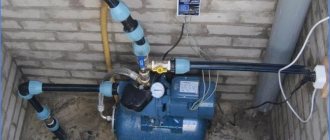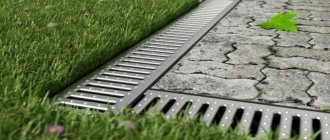The problem of high groundwater levels and constant flooding of the site can be solved by a drainage ditch. This is a simple engineering structure, which is a linear excavation along the border of the territory. It's easy to do it yourself.
A drainage ditch is a structure in the ground designed to protect the soil from erosion or waterlogging, collect surface water and drain it into the nearest watercourse.
What is a drainage ditch?
Strictly speaking, any drainage ditch is a special depression in the ground, arranged along the road or along the perimeter of an object or site.
A drainage ditch is a structure in the ground designed to protect the soil from erosion or waterlogging, collect surface water and drain it into the nearest watercourse.
The principle of its operation is extremely simple: water accumulated after intense rainfalls does not stagnate in the area, but flows along the bottom of the ditch into a specially equipped drain or into a natural reservoir. If water is drained from the overlying territory, then such a drainage ditch is called upland. And if the diversion is carried out along the perimeter of the site or along the road, then this is a ditch.
Major travel option
When constructing a major driveway, the technology of backfilling the pipe changes. Before laying the pipe, geotextiles or road mandrel are first laid on the prepared base, overlapping the ditch slopes. Then the pipe is laid and filled with crushed stone of a medium fraction of 20–60 mm. The woven material will not allow crushed stone to penetrate into the soil under load.
A frame of reinforcement is laid on top of the compacted crushed stone, and concrete is poured. Particular attention must be paid to the edges of the concrete surface. To prevent them from breaking off, a recess should be made at the ramps and the thickness of the concrete should be increased to 200 mm. Or lay a flat road curb along the edges of the concrete ramp.
What are the advantages of a drainage ditch?
First of all, such a ditch is designed to effectively drain water from the site. This way it will be possible to prevent such unpleasant phenomena as:
- flooding of the site and its waterlogging, the formation of puddles in the area;
- rotting of wooden structures and plant roots;
- inhibition of the growth of plantings on the territory;
- the appearance of fungi and mold on the walls of buildings;
- deterioration of health due to exposure to high humidity;
- accumulation of dirt on the site.
Precipitation and melted snow cause considerable harm to economic activity, increase excess moisture in the soil, which can spoil landscape design, lead to the death of garden plants and destroy the foundation of a building.
In addition, digging a ditch, as a rule, does not involve the use of specialized heavy construction equipment. Literally every owner can take the most ordinary bayonet shovel and dig a ditch on their own. A drainage ditch is also the cheapest and most effective drainage method. It will require virtually no cash costs.
Disadvantages of a drainage ditch
However, this method of organizing drainage also has its disadvantages. For example, a ditch is less efficient compared to linear storm drainage and even surface linear drainage.
The ditch does not have a long service life. However, if you approach its arrangement wisely and properly strengthen it, these terms will be extended significantly. But even so, the ditch needs regular maintenance - restoration of the embankment, cleaning and other repair work.
In addition, a drainage ditch can spoil the appearance of the site. But here, too, everything largely depends on the imagination of the owner himself. There are examples of drainage ditches successfully integrated into the landscape design and beautifully decorated.
A ditch is a long open drainage system of the simplest type, dug into the ground to collect and drain water that accumulates as a result of large amounts of precipitation.
Storm drainage system on the road
Groundwater, accumulating in the upper layers of the earth at low temperatures, freezes, expands and damages the road surface. They are a serious destructive factor. Over time, additional moisture enters the resulting cracks, which seeps into the soil, accelerating the destruction process.
Large accumulations of water on the roads often become the cause of traffic accidents, as the adhesion of the wheels to the road surface is disrupted and the vehicle becomes uncontrollable (hydroplaning effect). In conditions of dense city traffic, this is especially dangerous, as it poses a threat to life for drivers and pedestrians.
The entire storm drainage system is installed on the side of the road or under the road surface. It includes special gutters and edge trays.
To ensure more efficient drainage of water, the road surface is laid with a slope (one-sided or two-sided) towards the side of the road. In case this road is one-way, a one-way slope is used. On a multi-lane highway, a slope is designed in both directions, due to which the water flows through the gutters to the storm grates. The wastewater is directed through the edge trays to the discharge points.
If necessary, a special slope is designed. On roads with a large number of lanes, receiving trays are installed in the center, connected to edge gutters using pipes through which excess water drains.
Methods for draining water from roads are the same. There are differences in the design elements:
- by type: underground pipes or trays;
- on the base: single parts, concrete base or soil compaction;
- by the number of stripes: single-sided, double-sided or additional in the center.
When designing a road to install the most efficient drainage system, it is important to consider:
- climate of the area, namely: average annual precipitation and its intensity;
- the largest volume of waste. This unit is calculated based on observations over several years with the addition of a contingency reserve;
- the duration of the warm season, the number of cages in winter, the likelihood of spring floods, and so on.
If there is a high probability of spring floods, then laying closed drainage systems is not practical, as they will fail very quickly. Cleaning and reconstruction work is labor-intensive and requires large investments.
Drainage ditches are the most important element of the entire system. Drawings for them are prepared during road design. Taking into account climatic conditions, a method for strengthening slopes and trays is selected:
- use of concrete elements;
- concrete composite slabs;
- reinforcement with crushed stone or planting of perennial plants.
During the design, a drawing is drawn up indicating the profile of the roadway and the version of the receiving element used. At the moment, there are several standard proven and tested schemes that have been used in the construction of roads in various climatic conditions. If a stormwater system is installed in an area with a special climate, where there are significant differences in warm and cold seasons, then it is necessary to develop a special scheme to ensure uninterrupted operation of drainage systems.
Sandy asphalt concrete is considered the best structural material with which to effectively strengthen storm drainage gutters. It is a man-made building material that, unlike prefabricated asphalt blocks, is less susceptible to water. After its outflow, it does not collapse or become covered with cracks, which is especially important in regions with frequent floods. But, unfortunately, this reliable material is quite expensive, which makes it impossible to use it on a large scale. Therefore, it is used only on the most important sections of expressways or urban routes.
Where are drainage ditches primarily used?
A drainage ditch, as a rule, finds its application on not too large private plots. This is due to the low degree of automation of work on its arrangement. Therefore, on an industrial scale, drainage ditches are rarely used. This also happens due to the above-mentioned disadvantages - the need for frequent repairs, short service life, etc. It should also be borne in mind that, according to current regulations, it is forbidden to construct drainage ditches and lead them to:
- reservoirs where fish and other living organisms live;
- unfortified or washed out ravines and holes;
- rivers with running water;
- reservoirs that have beaches for recreation;
- as well as to natural lowlands where the area is prone to waterlogging.
Important! It is prohibited to construct drainage ditches in places where the level of groundwater flow is at a depth of less than two meters. This is because dirty wastewater may otherwise seep into the aquifer. If groundwater is expected to occur on the site, then the drainage channels are equipped with closed trays.
The disadvantage of drainage systems is erosion and collapse of walls. Paving a ditch with natural stone is a way to strengthen the slopes of a drainage ditch, as well as give it an aesthetic appearance.
What are the technical requirements for drainage ditches?
In order to ensure the greatest efficiency of the drainage ditch, certain standards must be observed. First of all, care must be taken to ensure the required degree of slope of the ditch. If it is dug in a small private area, then we can proceed from the principle: 2 cm of height change for every meter of ditch length. In the case of arranging drainage along roads and industrial facilities, an inclination angle of 3-5 degrees is considered optimal.
The greatest efficiency of a drainage ditch is ensured by organizing the required degree of its slope.
If, for some reason, it is impossible to provide the required degree of slope, then it is necessary to organize special fast flows and so-called water wells along the water path. The minimum flow speed should be 0.3 meters per second. In this case, the ditch can effectively cope in most cases even with relatively intense water flows. As for the dimensions of the ditch itself, they are as follows:
- width – about 50 cm;
- depth – at least 70 cm;
- the slopes on the sides should be at an angle of 30 degrees.
Equipment used for construction
Depending on many conditions, a very large amount of special equipment is used for the construction of drainage systems. These can be excavators, backhoe loaders, mini excavators, mini loaders, dump trucks. Depending on the complexity, different techniques are used.
However, it is worth mentioning separately the backhoe loader and mini excavator. This pair of equipment takes part in the construction of almost any drainage system. The advantage of mini excavators is that they move using caterpillar tracks. Therefore, this type of excavator can work even in the wettest and swampiest areas. A backhoe loader most often moves soil over short distances. When constructing most types of ditches, there is no need to load soil onto dump trucks, since it has to be moved over very short distances. It is for this reason that it is best to use a backhoe loader.
How can you strengthen a drainage ditch?
As already mentioned, one of the significant disadvantages that a drainage ditch has is that its walls and embankment are subject to natural destruction - crumbling and erosion. However, everyone can reduce the effect of this negative factor. And for this it is necessary to take measures to strengthen both the ditch itself and its slopes.
Firstly, even at the construction stage, it is necessary to ensure the presence of a special drainage sand and gravel layer along the edges of the ditch. A pillow 8 to 10 centimeters thick will be enough. After completion of the work, you can line the edges of the ditch with decorative or wild shrubs and trees. On the one hand, their root system will strengthen the walls of the ditch, and on the other hand, it will give it a more aesthetically attractive appearance.
Natural stone is often used to strengthen the ditch and also improve its appearance. With skillful layout, it can transform such a seemingly unprepossessing structure as a drainage ditch beyond recognition.
Geogrid is a honeycomb structure made of polyethylene tapes; it is used for reinforcing loose and heterogeneous soils, strengthening slopes and slopes.
It is also recommended to use a geogrid. With the help of special crutches it is attached to the bottom and walls of the ditch. The same material as geotextiles is recommended to be laid on the muddy soil of the main area of the canvas. The minimum thickness of the embankment on geotextiles should be at least 30 centimeters. Geotextiles can also be used to strengthen both the walls of the ditch and its bottom. The so-called turf is also used for this. The turf is cut into a thickness of 6 to 10 cm and laid out along the embankment. It can be secured with wooden knitting needles. Finally, you can simply show some imagination and use all kinds of available means to strengthen the ditch.
Standard moving option
Crushed stone is used for the base, and it is laid and compacted not only at the bottom of the ditch, but also on slopes. Concrete can be prepared on site and poured into prepared formwork. If the wall thickness is less than 400 mm, then a frame made of reinforcement is required. The wall thickness must be at least 25 cm.
Above the pipe, near the masonry or concrete wall, it is worth making a gap of 5–10 cm, which is sealed with soft insulating material. This will prevent the wall from affecting the ends of the pipe if there is slight subsidence, and will protect it from breaking into two parts. Particularly important for concrete collectors.
To prevent the car from sliding off, you should raise the wall above the roadway by 15 cm.
How to arrange a drainage ditch on your own
As a rule, owners of small plots prefer to make do with the arrangement of drainage ditches on their own. And in order for the ditch to operate with maximum efficiency, you first need to mark the area, taking into account the natural slope of the area. You can even make a plan on paper in advance. In order to understand from which places the water needs to be drained first, you can simply wait for the first downpour and see where exactly the water has accumulated the most.
The most successful option is if the site itself is a sloping area. In this case, it will be enough to simply dig a U-shaped or L-shaped ditch. The “herringbone” arrangement of the ditch is also spreading, all the “branches” of which enter areas of the territory and then merge together - into the “trunk”. Taking into account the above parameters of the slope and the dimensions of the channel, a trench is dug, then the ditch is strengthened using one of the methods proposed above.
With the help of drainage ditches, damp areas are drained to prepare areas intended for the construction of buildings and structures.
What experts say
The construction of drainage ditches on the site is a necessity. If the owner takes care of their arrangement in a timely manner, he can protect himself from many problems at once. And a drainage ditch is exactly where work should begin to improve any area.
Dmitriy.
When drawing up a diagram, you need to take into account the presence of obstacles and obstacles along the way. If there are bushes, they need to be torn down and replanted to avoid flooding of the root system. However, it is best, of course, to build a plan in such a way as to avoid any obstacles.
Alexander.











